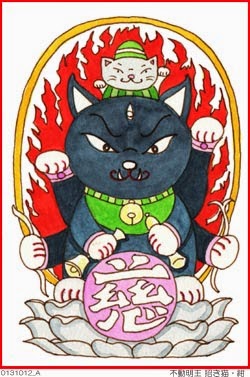LINK
http://fudosama.blogspot.jp/2014/10/kabuto-helmet.html
http://fudosama.blogspot.jp/2014/10/kabuto-helmet.html
:::::::::::::::::::::::::::::::::::::::::::::::::::::::::::::::::::::::::::::::::::::::::::::::::::::::::::::::::::::::::::
kabuto 兜 / 冑 / かぶと helmet
and Fudo Myo-O 不動明王
. musha ningyoo 武者人形 Samurai Dolls in armour .
- Introduction -
They are decorated for the Boy's Festival on May 5.
warrior dolls - kabuto ningyoo かぶと人形 "helmet dolls"
. yoroi Fudoo 鎧不動 Fudo on and in armour .
.......................................................................
- quote
Kabuto (兜, 冑) is a type of helmet first used by ancient Japanese warriors, and in later periods, they became an important part of the traditional Japanese armour worn by the samurai class and their retainers in feudal Japan.
Japanese helmets dating from the fifth century (long before the rise of the samurai class) have been found in excavated tombs. Called mabizashi-tsuke kabuto (visor-attached helmet), the style of these ancient helmets came from China and Korea and they had a pronounced central ridge.
The kabuto was an important part of the equipment of the samurai, and played a symbolic role as well, which may explain the Japanese expressions, sayings and codes related to them. One example is katte kabuto no o o shimeyo (lit. "Tighten the string of the kabuto after winning the war"). This means don't lower your efforts after succeeding (compare to "not to rest on one's laurels").
Also, kabuto o nugu (lit. "to take off the kabuto") means to surrender.
- - - - - Parts of the kabuto
datemono だてもの ( 立物 (たてもの)tatemono) - crest on the helmet
various crests worn on the top (kashiradate 頭立), back (ushirodate 後立), sides (wakidate 脇立) or front (maedate 前立) of a Japanese helmet (kabuto).
- source : wikipedia
:::::::::::::::::::::::::::::::::::::::::::::::::::::::::::::::::::::::::::::::::::::::::::::::::::::::::::::::::::::::::::
兜の前立ては倶利伽羅龍王
Kurikara Dragon Deity as front crest

From the Tokugawa clan of Kii 紀伊徳川家伝来
- source : nekoarena.blog31 -
. Kurikara 倶利伽羅 the Sword of Fudo Myo-o .
:::::::::::::::::::::::::::::::::::::::::::::::::::::::::::::::::::::::::::::::::::::::::::::::::::::::::::::::::::::::::::
不動明王の持つ三鈷剣をモチーフにした前立
sanko-ken 三鈷剣 "three-pronged vajra sword"

- source : fuhrinkazan.blog87
.......................................................................
mitsukuwa, mitsu kuwa 三ツ鍬形 / ken 劍
(kuwagata 鍬形 front piece)
劍 - sword of Fudo Myo-O

劍 (不動明王の象徴といわれている)を立てた鍬形
- source : www.kingyo-ya.com
.......................................................................
Helmet of 榊原康政 Sakakibara Yasumasa (1548 - 1606)
徳川四天王 one of the four famous retainers of Tokugawa Ieyasu

- - - - -
不動明王。江戸期の兜 helmet from the Edo period

- - - - -
with Sanskrit letters for Dainichi Nyorai 大日如来
政宗 Masamune

- source and more helmets : blog.goo.ne.jp/nf6ecvga
:::::::::::::::::::::::::::::::::::::::::::::::::::::::::::::::::::::::::::::::::::::::::::::::::::::::::::::::::::::::::::
く徳川四天王の一人榊原康政の兜
with the design of Yasumasa's helmet for a teeshirt or sweatshirt

- source : www.colors-ysn.com/products
.......................................................................
Tokugawa Shitenno 徳川四天王 four famous retainers of Tokugawa Ieyasu
Two of them have Fudo Myo-O's sword as helmet crest:

CLICK for more photos !
Honda Tadakatsu 本多忠勝 (1548–1610)
Ii Naomasa 井伊直政 (1561–1602)
Sakai Tadatsugu 酒井忠次 (1527–1596)
Sakakibara Yasumasa 榊原康政 (1548–1606)
- - - More in the WIKIPEDIA !
:::::::::::::::::::::::::::::::::::::::::::::::::::::::::::::::::::::::::::::::::::::::::::::::::::::::::::::::::::::::::::

. - Join Fudo Myo-O on facebook - Fudō Myō-ō .
:::::::::::::::::::::::::::::::::::::::::::::::::::::::::::::::::::::::::::::::::::::::::::::::::::::::::::::::::::::::::::
. Pilgrimages to Fudo Temples 不動明王巡礼
Fudo Myo-O Junrei - Fudo Pilgrims .
[ . BACK to WORLDKIGO . TOP . ]
[ . BACK to DARUMA MUSEUM TOP . ]
:::::::::::::::::::::::::::::::::::::::::::::::::::::::::::::::::::::::::::::::::::::::::::::::::::::::::::::::::::::::::::
kabuto 兜 / 冑 / かぶと helmet
and Fudo Myo-O 不動明王
. musha ningyoo 武者人形 Samurai Dolls in armour .
- Introduction -
They are decorated for the Boy's Festival on May 5.
warrior dolls - kabuto ningyoo かぶと人形 "helmet dolls"
. yoroi Fudoo 鎧不動 Fudo on and in armour .
.......................................................................
- quote
Kabuto (兜, 冑) is a type of helmet first used by ancient Japanese warriors, and in later periods, they became an important part of the traditional Japanese armour worn by the samurai class and their retainers in feudal Japan.
Japanese helmets dating from the fifth century (long before the rise of the samurai class) have been found in excavated tombs. Called mabizashi-tsuke kabuto (visor-attached helmet), the style of these ancient helmets came from China and Korea and they had a pronounced central ridge.
The kabuto was an important part of the equipment of the samurai, and played a symbolic role as well, which may explain the Japanese expressions, sayings and codes related to them. One example is katte kabuto no o o shimeyo (lit. "Tighten the string of the kabuto after winning the war"). This means don't lower your efforts after succeeding (compare to "not to rest on one's laurels").
Also, kabuto o nugu (lit. "to take off the kabuto") means to surrender.
- - - - - Parts of the kabuto
datemono だてもの ( 立物 (たてもの)tatemono) - crest on the helmet
various crests worn on the top (kashiradate 頭立), back (ushirodate 後立), sides (wakidate 脇立) or front (maedate 前立) of a Japanese helmet (kabuto).
- source : wikipedia
:::::::::::::::::::::::::::::::::::::::::::::::::::::::::::::::::::::::::::::::::::::::::::::::::::::::::::::::::::::::::::
兜の前立ては倶利伽羅龍王
Kurikara Dragon Deity as front crest

From the Tokugawa clan of Kii 紀伊徳川家伝来
- source : nekoarena.blog31 -
. Kurikara 倶利伽羅 the Sword of Fudo Myo-o .
:::::::::::::::::::::::::::::::::::::::::::::::::::::::::::::::::::::::::::::::::::::::::::::::::::::::::::::::::::::::::::
不動明王の持つ三鈷剣をモチーフにした前立
sanko-ken 三鈷剣 "three-pronged vajra sword"

- source : fuhrinkazan.blog87
.......................................................................
mitsukuwa, mitsu kuwa 三ツ鍬形 / ken 劍
(kuwagata 鍬形 front piece)
劍 - sword of Fudo Myo-O

劍 (不動明王の象徴といわれている)を立てた鍬形
- source : www.kingyo-ya.com
.......................................................................
Helmet of 榊原康政 Sakakibara Yasumasa (1548 - 1606)
徳川四天王 one of the four famous retainers of Tokugawa Ieyasu

- - - - -
不動明王。江戸期の兜 helmet from the Edo period

- - - - -
with Sanskrit letters for Dainichi Nyorai 大日如来
政宗 Masamune

- source and more helmets : blog.goo.ne.jp/nf6ecvga
:::::::::::::::::::::::::::::::::::::::::::::::::::::::::::::::::::::::::::::::::::::::::::::::::::::::::::::::::::::::::::
く徳川四天王の一人榊原康政の兜
with the design of Yasumasa's helmet for a teeshirt or sweatshirt

- source : www.colors-ysn.com/products
.......................................................................
Tokugawa Shitenno 徳川四天王 four famous retainers of Tokugawa Ieyasu
Two of them have Fudo Myo-O's sword as helmet crest:

CLICK for more photos !
Honda Tadakatsu 本多忠勝 (1548–1610)
Ii Naomasa 井伊直政 (1561–1602)
Sakai Tadatsugu 酒井忠次 (1527–1596)
Sakakibara Yasumasa 榊原康政 (1548–1606)
- - - More in the WIKIPEDIA !
:::::::::::::::::::::::::::::::::::::::::::::::::::::::::::::::::::::::::::::::::::::::::::::::::::::::::::::::::::::::::::

. - Join Fudo Myo-O on facebook - Fudō Myō-ō .
:::::::::::::::::::::::::::::::::::::::::::::::::::::::::::::::::::::::::::::::::::::::::::::::::::::::::::::::::::::::::::
. Pilgrimages to Fudo Temples 不動明王巡礼
Fudo Myo-O Junrei - Fudo Pilgrims .
[ . BACK to WORLDKIGO . TOP . ]
[ . BACK to DARUMA MUSEUM TOP . ]
:::::::::::::::::::::::::::::::::::::::::::::::::::::::::::::::::::::::::::::::::::::::::::::::::::::::::::::::::::::::::::








































